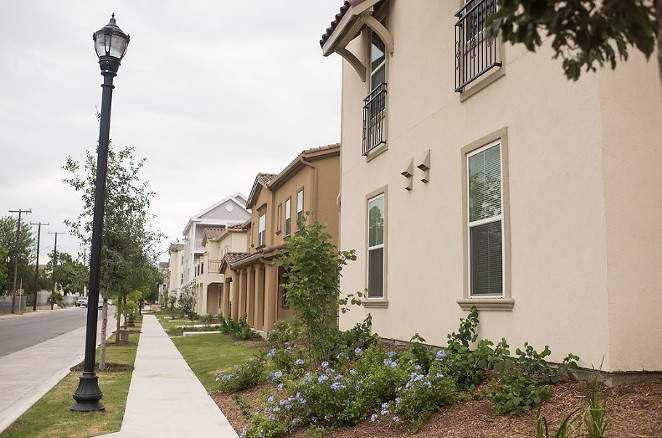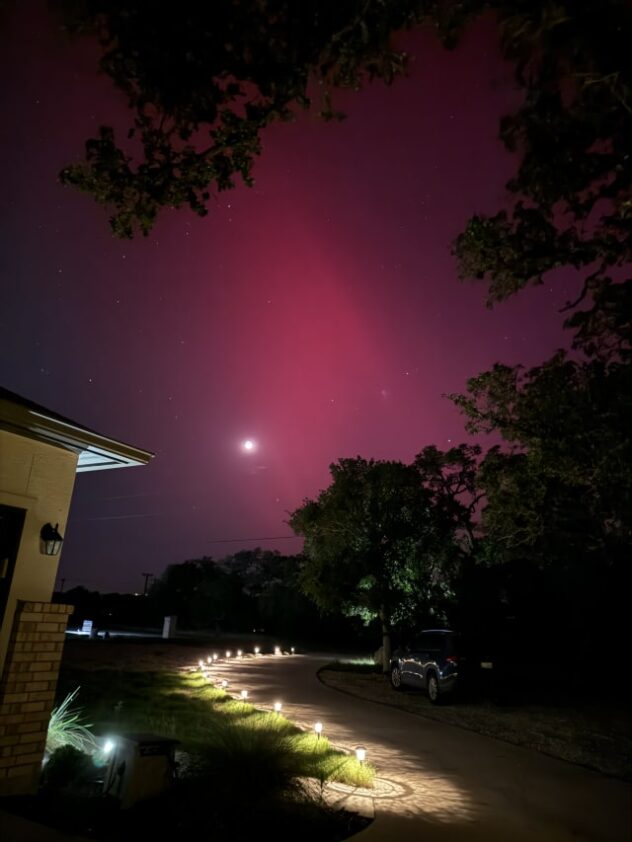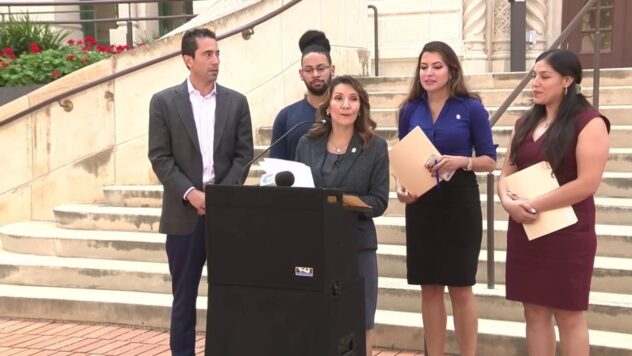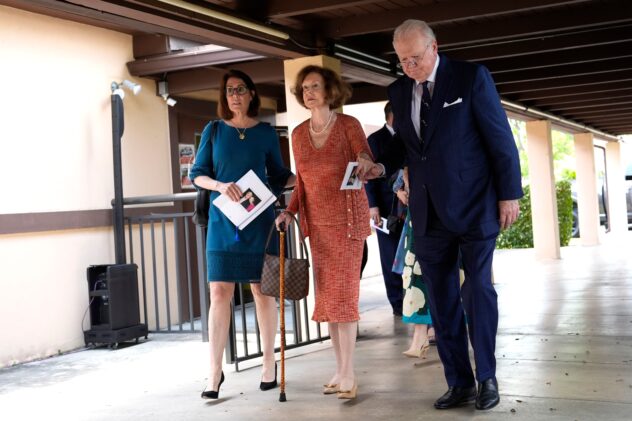San Antonio Housing Authority and critics feud over relocation of Alazan Courts residents

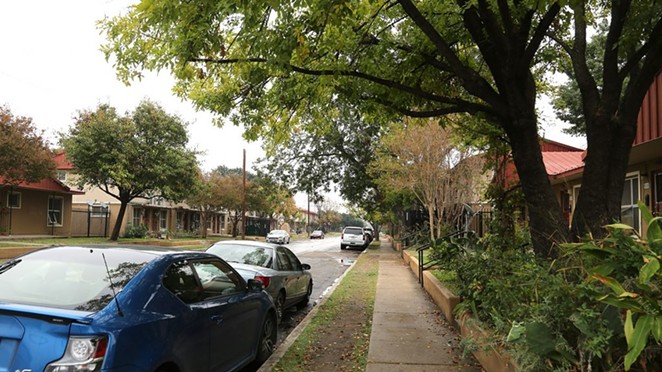
- Photo by Ben Olivo / San Antonio Heron
- The Alazan side of the Alazan-Apache Courts in 2019.
Olga Kauffman, a healthcare consultant, has seen first hand what happens to poor people when they’re displaced from public housing, which is then leveled to make room for mixed-income apartments.
Families must locate a new school for their kids, a new doctor, they have to find the social services, if they even exist, in their new neighborhood. Where they didn’t need a car before, now they do living out in Loop Land.
Some, Kauffman said, don’t survive the transition.
“Some of them ended up . . . in a lot of really bad places, like Haven For Hope or in jail,” Kauffman said last week, “and the kids dropping out of school.”
In 2014, the San Antonio Housing Authority (SAHA) had demolished the 248-unit Wheatley Courts on the East Side and began building the mixed-income development that’s there now: East Meadows, the townhome and craftsman-style apartment complex wedged firmly inside the Harvard Place-Eastlawn neighborhood, where public housing used to be.
Back then, SAHA received a federal Choice Neighborhood grant worth nearly $30 million, which helped kickstart the sprawling redevelopment of more than 400 apartments. With Choice, displaced residents were provided a case manager to walk them through their transition rather than merely covering moving costs.
Kauffman was one of those case managers, and now serves on SAHA’s board of commissioners.
Last Thursday during SAHA’s monthly board meeting, Kauffman heard SAHA officials explain that the agency wants to do a Choice grant-style redevelopment at the Alazan Courts on the near West Side, but without the Choice grant—the logistics and consequences of which concern her.
SAHA’s ambitious plan would demolish the circa-1940 barracks-style Alazan Courts—all 501 public housing units on 26 acres west of downtown—and replace it with mixed-income apartments, potentially around 700 units.
The master plan for Alazan, where the average household makes $8,700 a year, lacks complete funding and its timeline is hazy.
It’s also found a growing number of activists against it, many of whom have been fighting to preserve the Alazan Courts since SAHA unsuccessfully applied for the Choice grant in 2017, and who have been reinvigorated recently by the National Trust for Historic Preservation naming “Los Courts” one of America’s most endangered historic places.
The group of several dozen spoke against SAHA’s plan last week, but also blasted the agency for other reasons, including the poor conditions of its public housing stock and its practice of partnering with for-profit developers, such as S.A.-based Lynd Company and Dennis McDaniel of Austin.
SAHA argues the partnerships are necessary in order to generate enough revenue to cover the cost of upgrading public housing, among other expenses, because of diminishing capital dollars from the U.S. Department of Housing and Urban Development (HUD). Profits will also be used to underwrite more deeply affordable units elsewhere, actually increasing the number of affordable units in San Antonio, the agency says, while providing developers with tax breaks and other subsidies.
Officials also say, without the Choice grant, they’ll need funding to support Alazan residents during their transition.
SAHA contends the courts are beyond repair and describes the strategy as the beginning of the West Side’s revitalization after decades of neglect. Preservation groups call it the beginning of the gentrification of the West Side, where San Antonio’s cultural roots are planted.
‘The stress level does go up’
Just as it did at the Wheatley Courts, SAHA will provide Alazan residents with a housing voucher, made available by HUD, should they want one.
But Kauffman, who started working with Wheatley Courts families in 2015, saw first hand how voucher holders get the door slammed on them by landlords not willing to accept them.
“For a lot of those families, their dream is to live in a house with their children in a neighborhood, where their kids can walk to school, and just have a backyard to play in—the American Dream, I guess,” Kauffman, who worked for a group funded under Choice called Urban Solutions, said in an interview this week. “So they saw this as an opportunity to do that. But unfortunately, there’s not enough Section 8 housing to go around.”
“They could still go into an apartment, but they held onto their voucher until the very end. It was almost impossible to find a house. A few lucky ones did, but you have to be able to be very flexible on where you were able to move to in the city.”
During last week’s meeting, SAHA President and CEO David Nisivoccia said the agency is required by federal law to assist residents who are displaced by federally-backed projects such as this one with moving costs, including transportation when home or apartment hunting.
He also talked specifically about working with Alazan residents to improve their credit scores, so they can better their chances of a landlord accepting their Section 8 voucher. Nisivoccia sees the process taking up to 18 months, “We have to start actually engaging with residents sooner than later.”
Kauffman’s concerns at Alazan are focussed on what happens after the move. Many families she worked with left Wheatley in 2014; and she’s assisted them up until January this year, when the Choice program ended.
“The stress level does go up … their kids get in trouble,” Kauffman said. “Not being able to find other resources because they have to get to know the area they’re at. Getting transportation—a lot of them didn’t need a car at the Wheatley Courts. There were a lot of issues.”
Kauffman, who believes the Alazan plan should combine historic preservation with new dwellings, said she wonders how SAHA will fund this type of long-term case management.
Nisivoccia described the need to bolster funding for its Community Development Initiatives Department, which offers social services to SAHA residents. “We think that’s vital,” he said. “We’re not just about sticks and bricks, we’re about flesh and blood.”
Under Choice, Urban Solutions was given $4 million to help roughly 200 families transition from Wheatley, Kauffman said. She said they did the best they could, but even $4 million wasn’t enough. That was for 200 families. At Alazan, there are 500.
The Alazan debate
SAHA critics say Alazan just shouldn’t be demolished.
Three weeks ago, the National Trust for Historic Preservation agreed and named “Los Courts,” as they’re called on the West Side, one of the 11 most endangered historic places in the U.S.
“Particularly during this time of economic crisis, the preservation of historic buildings that provide affordable housing—and the communities that call those places home—should be a priority not only for San Antonio, but all cities nationwide,” Katherine Malone-France, the National Trust’s chief preservation officer, said.
Dr. Ana Margarita “Cha” Guzman, who was appointed as SAHA’s chairwoman by Mayor Ron Nirenberg a month after the Alazan plan was approved by the previous board, in late 2019, said it’s time for the courts to be torn down and rebuilt.
“It’s time to do the hard work, because working on the West Side is never easy,” Guzman said. “We need to do the hard work and make those Alazan-Apache beautiful again.”
In February, SAHA went door to door at Alazan, and surveyed residents about the master plan.
The results showed 78% of residents prefer an Alazan rebuild, while 21% prefer a remodel. From that survey, 89% of residents said they were willing to relocate, while 10% said they wanted to stay, according to SAHA. Because of the pandemic, the survey ended in June having reached 130 households.
“I do understand that some people are saying it’s historical and a part of our culture, but I feel our people have been brainwashed to believe this because our culture isn’t symbolized by old beat up buildings,” Jeannette Rico, an Alazan resident who’s defended the master plan before, said in a written statement to the board.
The West Side preservationists contend SAHA is uprooting an entire community, one that will be replaced by more affluent residents. The agency will be the direct and sudden cause of gentrification, they say, as opposed to riding the gradual wave of upper-class people moving in. They say the concrete and brick buildings should be rehabbed, thus preserving not just the physical structures but also the community of 1,200 low-income residents.
“To demolish the courts would not only bring the loss of an architecturally significant site, but also the loss of a deeply embedded community, while paving the way for the gentrification that has already taken over other downtown adjacent neighborhoods,” said Graciela Sanchez, director of the Esperanza Peace & Justice Center, whose Rinconcito de Esperanza next to Alazan serves as a community gathering space and cultural center.
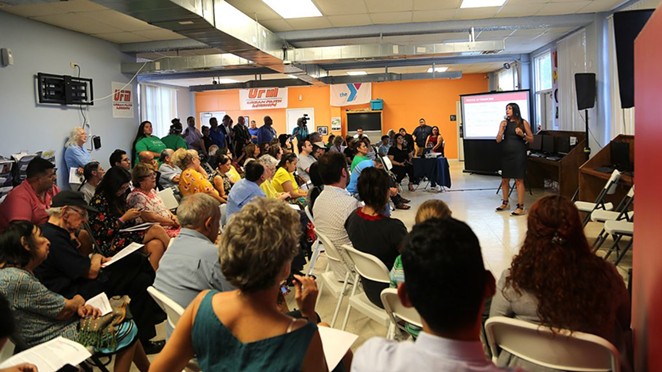
- Photo by Ben Olivo / San Antonio Heron
- People packed the Alazan Community Center in 2019 for a meeting about new development.
SAHA paints a different picture.
In 2017, local firm Muñoz and Company did an assessment of roughly 10% of the units at Alazan Courts, and found none of them to be in acceptable condition. The firm recommended repairing 45 units, and found 12 whose repairs were “necessary.” Another five units, the firm said, were approaching critical condition.
“The assessment team’s recommendation is to replace the existing Alazan Courts and reconstruct the property with entirely new construction,” wrote Geoff Edwards, principal at Muñoz.
However, the report also appears to contradict itself.
In an executive summary, Edwards writes that the cost to rebuild 501 units would be $52.6 million. Then, Edwards says, “The opinion of cost for renovation of the building to address critical, near critical, necessary and recommended repairs to the building and site is $35.4 million.”
According to Michael Reyes, SAHA spokesman, the $35.4 million estimate “is just for critical needs or band-aids, if you will. It doesn’t include full modernization rehab costs.”
According to SAHA, the 80-year-old buildings, with their hollow masonry walls, cannot accommodate modern HVAC systems. The City of San Antonio also requires a renovation of more than 50% of the structure to be brought to modern building codes, “including fire protection and handicap accessibility,” SAHA says.
But the preservationists question why SAHA allowed Alazan to deteriorate into the condition they’re in now. During the meeting, they also said the issue is wider than just Alazan, saying 13 SAHA properties failed HUD inspections. It’s a figure Nisivoccia disputes, saying HUD changes its scoring methodology, which caused a dip in public housing scores nationwide.
“You cannot justify in any way spending money in any other capacity before making sure the units that you already have are livable for the residents,” Kayla Miranda, a resident of the nearby Apache courts, said during the meeting. Each member of the group punctuated their remarks with the slogan, “People over profit.”
Nisivoccia described a declining yearly capital budget form D.C.
“On a good year, we receive $13 million a year (from HUD) for our full portfolio,” he said. “Once you strip away some soft costs and a loan the agency took out on that program years ago, we have about $7-$8 million to spread across 6,000 public housing units. If you take the average cost of wanting to renovate or fix up versus redevelop, about $100,000 per unit, at 500 units: that’s $50 million. That would be about 10 full years of our capital fund program and ignoring the rest of our portfolio. I want all the residents to know and understand: We’re not ignoring Alazan. It’s just a financial challenge. … The deterioration of Alazan has been happening over 20-30 years.”
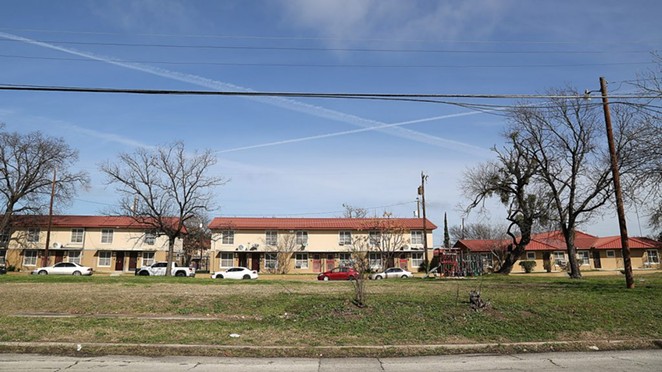
- Ben Olivo / San Antonio Heron
- his patch of land on the northwest corner of South Colorado and El Paso streets—adjacent to the Alazan Courts—will become The Legacy at Alazan, a new mixed-income development. Photo by Ben Olivo | Heron
Hope VI and choice
In late 2019, SAHA’s board selected NRP Group as the master developer for Alazan and approved the demolition of the courts in phases, over multiple years. The agency has admitted it made a mistake in demolishing the Wheatley Courts at once, which scattered its residents across San Antonio.
According to SAHA, of the 205 families who were relocated, 50 returned to public housing at East Meadows, 56 found housing through the voucher, and 99 are no longer in SAHA programs.
The Choice program under President Obama was a more holistic approach to de-concentrating public housing than its antecedent, the Hope VI program under President Clinton and former U.S. Department of Housing and Urban Development (HUD) Secretary Henry Cisneros. The program introduced the concept of eliminating distressed public housing, and replacing it with a mix of tenants from various socio-economic backgrounds. The philosophy has its supporters, and its detractors.
In 1998, SAHA received a Hope VI grant for the demolition of nearly 800 units of Victoria Courts, south of Hemisfair. What’s followed is a multi-phased development that began with the 210-unit Refugio Place in 2004, followed by the 245-unit Hemisview Village in 2014—both mixed-income. Townhomes and single-family homes also followed in the master development that’s still being planned and built. In all, SAHA is looking to build more than 1,500 units, mostly apartments, in this corner of the Lavaca neighborhood south of downtown.
Even today, more than 20 years after SAHA received the initial Hope VI funding from HUD, SAHA still hasn’t replaced all of the public housing units from the Victoria Courts it was required to replace under the program. The 40 remaining units are to be included in a new development called The Legacy at Alazan, an 88-unit apartment complex with public housing, below-market-rate units, and market-rate apartments—which are being built next to the Alazan Courts. Construction is scheduled to begin in the fall and is expected to be completed in 18 months.
Now, SAHA is trying to execute the philosophies of Choice on its own. It will require a patchwork of funding, which was necessary at East Meadows, even with the Choice grant.
In January, SAHA received what’s called a “carryforward designation” from the Texas Bond Review Board, a certificate that allows the agency to issue up to $44 million in bonds toward Alazan. But the pandemic has delayed the project, and SAHA now has roughly two years to spend the money or lose it, officials told the board last week. According to SAHA officials, HUD still must approve the Alazan plan, which includes environmental work associated with demolition—a process that could take 10 to 12 months.
SAHA must also tap into low-income housing tax credits, although that program is not guaranteed and is highly competitive among affordable housing developers in the private sector. It’s also guaranteed to chip in its own equity. For East Meadows, SAHA contributed roughly $7 million from the agency’s reserves to make that redevelopment a reality, Nisivoccia told the Heron in a recent interview.
Guzman, SAHA’s chairwoman, instructed SAHA officials to expedite the project and spend the bond dollars within the two-year window. Officials said they would return to the board with different unit mix scenarios.
“No matter what we do here, this is not a project where we’re going to make money,” said Tim Alcott, SAHA’s real estate and legal services officer. “This is a mission-oriented development, and we’ll be putting cash into this development to make it work.”
If an Alazan resident chooses to stay on the West Side, SAHA said is building affordable housing inside mixed developments such as Legacy. A 102-unit project called Artisan at Ruiz west of North Zarzamora Street and the 200-unit Tampico Apartments near San Fernando Cemetery No. 1 are two other examples.
SAHA plans to eventually demolish its remaining public housing stock, nearby Apache, Lincoln and Cassiano courts, all located on the West Side. When—if—that happens, those residents will need support, Kauffman said.
“We all know that moving is a very stressful thing for families,” she said, “but it’s even more stressful for people that have no resources, and they don’t have the knowledge of where they’re going to end up.”
The San Antonio Heron is a nonprofit news organization dedicated to informing its readers about the changes to downtown and the surrounding communities.
Stay on top of San Antonio news and views. Sign up for our Weekly Headlines Newsletter.

